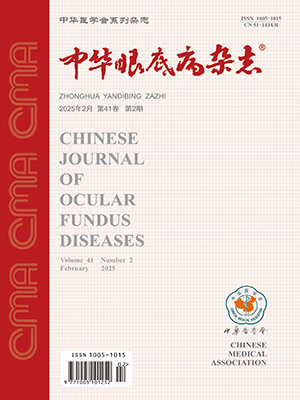Objective To observe the changes of intraocular pressure (IOP) after intravitreous injection wih triamcinolone acetonide (TA) and their affected factors. Methods The clinical data of 125 patients (125eyes) who had undergone intravitreous injection with TA were retrospectively analyzed. The patients (52 males and 73 females) aged from 17 to 83 years with the average age of 56.5. There were 49 patient (39.2%) with diabetic retinopathy (DR), 56 (44.8%) with retinal vein occlusion (RVO), and 20 (16.0%) with exudative age-related macular degeneration (AMD). One day before the treatment, IOP was measured by Goldmann applanation tonometry, and the basic IOP was 7~31 mm Hg (1 mm Hg=0.133 kPa) and the average IOP was (14.69 plusmn;3.72) mm Hg. The patients were divided into two groups according to the basic IOP:below 15 mm Hg group (n=64) and 15 mm Hg or above group (n=61). All of the patients underwent intravitreous injection with 4mg TA. IOP was measured 1 day, 3 days, 1 week, 2 weeks, and 1 month after the treatment in the same way, respectively, and later was measured once every 1 month. The follow-up period was 3~21 months with the mean of 5 months. The elevation of IOP would be defined as the pressure of 21mmHg or higher. The changes of IOP in patients before and after the treatment, and with different diseases and ages were analyzed. Results Thirty-six patients (28.8%) had elevation of IOP after the treatment, out of whom 97.2% had the elevation within 3 months after the injection and decreased to the basic level 7 months after the injection. In these patients, there were 11 (17.19%) in the below 15 mm Hg group and 25 (40.98%) in 15 mm Hg or above group, and the difference between the two groups was statistically significant (P<0.01). During the followup period, the mean maximum IOP was (20.09 plusmn;7.58) mmHg, which was 5.43 mmHg higher than that before the treatment(P<0.001). The mean maximum IOP of 53 patients (42.4%) after the treatment was 5 mm Hg higher than that before the treatment. The mean maximum IOP during the followup period was (18.19 plusmn;4.73)mmHg in DR group,(22.50 plusmn;9.30)mmHg in RVO group, and(18.12 plusmn;6.09)mmHg in AMD group. The occurrence of the elevation of IOP in RVO group was obviously higher than that in the other 2 groups (P<0.01). The result of regression analysis showed that age was correlative with the elevation of IOP after the treatment: more risks of occurrence of high IOP were found in younger patients (P=0.000). Conclusion Elevation of IOP after intravitreous injection with TA is common, which is correlative with the basic IOP, age, and pathogeny. After the intravitreous injection with TA, the elevation of IOP often occurs in patients with high basic IOP before treatment, younger age, and RVO. (Chin J Ocul Fundus Dis, 2007, 23: 115-117)
Citation: QIAN Tong,LI Xiaoxin. Changes of intraocular pressure after intravitreous injection with triamcinolone acetonide. Chinese Journal of Ocular Fundus Diseases, 2007, 23(2): 115-117. doi: Copy
Copyright © the editorial department of Chinese Journal of Ocular Fundus Diseases of West China Medical Publisher. All rights reserved




